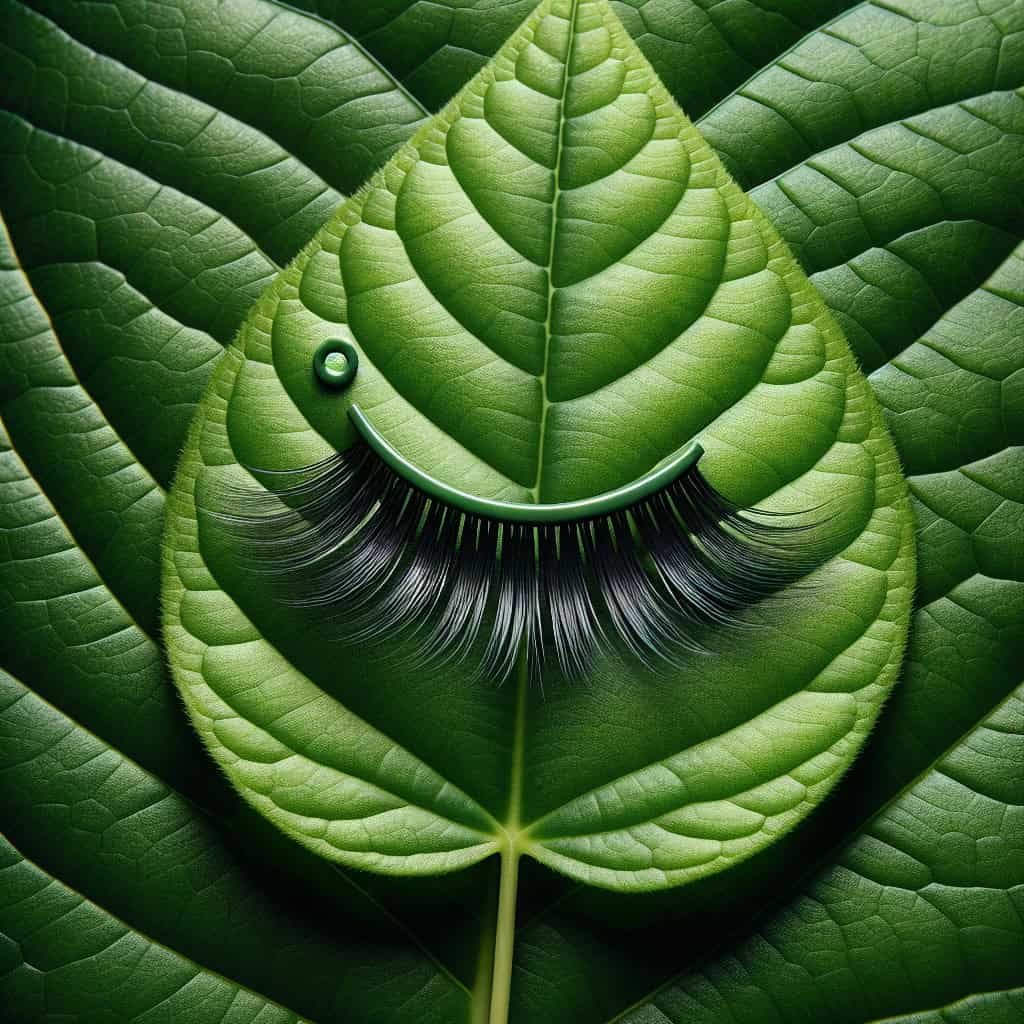If you’re on the lookout for glamorous lashes that won’t harm the environment, we’ve got you covered! In this article, we’ll explore the world of eco-friendly and sustainable false eyelashes. From biodegradable options to cruelty-free alternatives, we’ll provide you with a range of recommendations that not only enhance your beauty but also align with your eco-conscious values. Get ready to bat your sustainable lashes with confidence, because finding the perfect pair doesn’t have to mean compromising on our planet’s well-being.

Different Types of False Eyelashes
When it comes to false eyelashes, there are various types available in the market. Understanding the differences between them can help you make an informed choice that aligns with your values and preferences.
Synthetic false eyelashes
Synthetic false eyelashes are the most common and affordable option. They are made from synthetic materials such as plastic fibers. These lashes can be found in a wide range of styles and designs, making them versatile for different makeup looks. However, it’s important to note that synthetic lashes are not biodegradable and contribute to plastic waste.
Mink fur false eyelashes
Mink fur false eyelashes are known for their luxurious and natural appearance. These lashes are made from the shed fur of minks, which are semi-aquatic animals. While they provide a realistic look, the production of mink fur lashes involves animal cruelty and raises ethical concerns. Many people opt for alternative options to avoid supporting this industry.
Silk false eyelashes
Silk false eyelashes are made from silk fibers, providing a glossy and lightweight feel. These lashes are often praised for their natural appearance and durability. However, like synthetic lashes, silk false eyelashes are not biodegradable and can contribute to plastic waste if not disposed of properly.
Human hair false eyelashes
Human hair false eyelashes are made from real human hair, often sourced from ethical and sustainable suppliers. These lashes offer a natural look and feel, as the hair is similar to our own. However, some individuals may have ethical concerns regarding the sourcing of human hair.
Environmental Impact of False Eyelashes
While false eyelashes enhance our beauty and confidence, it’s essential to consider the environmental impact associated with their production and disposal.
Plastic waste
One of the key environmental concerns with false eyelashes is the plastic waste they generate. Most false eyelashes are packaged in plastic containers and are themselves made from plastic materials. When disposed of improperly, these lashes end up in landfills and contribute to the growing plastic pollution problem.
Animal cruelty
Certain types of false eyelashes, such as mink fur lashes, involve the cruel treatment of animals. Minks are often kept in cramped and unsanitary conditions, enduring physical and emotional stress. Supporting brands that engage in animal cruelty is against the principles of eco-friendly and sustainable choices.
Carbon footprint
The production and transportation of false eyelashes contribute to greenhouse gas emissions and our overall carbon footprint. From the manufacturing facilities to the supply chain involved in bringing the lashes to consumers, each stage adds to the environmental impact. Opting for sustainable alternatives can help minimize this carbon footprint.
Landfill contribution
False eyelashes contribute to landfill waste, primarily due to their non-biodegradable materials. When discarded incorrectly, these lashes can take a significant amount of time to break down, further burdening our already overflowing landfills. Making environmentally conscious choices can reduce the amount of waste ending up in our landfills.
Brands and Companies Promoting Eco-friendly False Eyelashes
As the demand for eco-friendly beauty products grows, many brands and companies have started promoting false eyelashes that are more sustainable and environmentally conscious. Here are some examples:
Eylure
Eylure is a well-known brand that offers a wide range of false eyelashes, including eco-friendly options. They have introduced lashes made from biodegradable materials, aiming to reduce the environmental impact associated with false eyelashes.
EcoTools
EcoTools is a brand committed to creating eco-friendly beauty products, including sustainable false eyelashes. Their lashes are made from recycled and renewable materials, ensuring minimal harm to the environment.
Velour Lashes
Velour Lashes is another brand that emphasizes sustainability in their products. They offer false eyelashes made from ethically sourced mink fur, ensuring the welfare of animals involved. Velour Lashes also focuses on minimizing packaging waste and using recyclable materials.
House of Lashes
House of Lashes is a cruelty-free brand that offers a range of false eyelashes made from synthetic and human hair fibers. They prioritize ethical production practices and aim to create sustainable options for lash enthusiasts.
Natural Alternatives to False Eyelashes
If you’re looking for alternatives to false eyelashes altogether, there are natural options available that can promote the growth and health of your own lashes.
Eyelash serums and growth enhancers
Eyelash serums and growth enhancers are products designed to stimulate lash growth and improve their overall health. These products usually contain ingredients such as peptides, vitamins, and plant extracts that nourish and strengthen lashes.
Castor oil
Castor oil is a popular natural remedy known for its potential benefits for hair growth. Applying a small amount of castor oil to your lashes daily can help promote their growth and thickness. It’s essential to choose cold-pressed and organic castor oil for the best results.
Coconut oil
Coconut oil is another natural ingredient that can nourish and hydrate your lashes. Apply a small amount of melted coconut oil to your lashes before bed and rinse it off in the morning. Regular use can help improve the condition of your lashes.
Vitamin E oil
Vitamin E oil is known for its antioxidant properties, which can contribute to healthier lashes. Gently apply a small amount of vitamin E oil to your lashes before bed to nourish and protect them. Look for high-quality, pure vitamin E oil for best results.

Recycling and Upcycling False Eyelash Packaging
To minimize the environmental impact of false eyelashes, it’s essential to properly dispose of or creatively repurpose their packaging. Here are some tips for handling false eyelash packaging in an eco-friendly way.
Separating plastic and cardboard components
Many false eyelash packages have plastic inserts for holding the lashes and cardboard or paper outer packaging. To recycle them properly, remove any plastic parts and separate them from the cardboard or paper. This ensures that each component can be recycled separately.
Repurposing packaging for storage or crafts
Instead of throwing away the packaging, consider repurposing it for storage or crafts. The plastic trays can be used to organize small beauty items or jewelry, while the cardboard packaging can be transformed into gift tags or bookmarks. Get creative and give these materials a second life.
Using refillable false eyelash cases
Some brands offer refillable false eyelash cases, where you can simply replace the lashes without discarding the entire packaging. These cases are designed to reduce waste and promote sustainability. Look for brands that offer these refillable options to minimize your environmental impact.
Eco-friendly False Eyelash Adhesives
In addition to considering the lashes themselves, it’s important to think about the adhesive used to apply them. Eco-friendly false eyelash adhesives are available, providing a more sustainable option for lash lovers.
Water-based adhesives
Water-based adhesives are a popular choice for those seeking eco-friendly options. These adhesives are gentle on the skin and often biodegradable. They offer a reliable hold while being more environmentally conscious compared to other adhesive options.
Latex-free adhesives
For individuals with latex allergies or those looking to avoid animal-derived ingredients, latex-free adhesives are the way to go. These adhesives provide a secure hold without the need for latex, making them a suitable choice for sensitive skin.
Formaldehyde-free adhesives
Formaldehyde is a harmful chemical often found in adhesives. Opting for formaldehyde-free adhesives ensures that you’re not exposing yourself to unnecessary toxins while being mindful of the environment. Look for brands that explicitly state their adhesives are formaldehyde-free.
Biodegradable adhesive options
Some brands have started manufacturing biodegradable false eyelash adhesives. These adhesives are designed to break down naturally after use, minimizing their impact on the environment. Consider exploring brands that offer such adhesive options for a more eco-friendly choice.

Exploring Sustainable Materials for False Eyelashes
The materials used to create false eyelashes play a significant role in their environmental impact. Here are some sustainable alternatives to traditional false eyelash materials:
Bamboo false eyelashes
Bamboo is a fast-growing and renewable resource, making it an excellent choice for sustainable false eyelashes. Bamboo lashes are lightweight, durable, and have a natural appearance. Look for brands that source their bamboo responsibly and prioritize sustainability in their production processes.
Paper false eyelashes
Paper false eyelashes are an innovative and environmentally-friendly option. These lashes are made from thin and flexible paper materials, providing a unique look and feel. Paper lashes are often biodegradable and can be easily recycled after use.
Plant-based fiber false eyelashes
Plant-based fiber lashes are made from organic materials such as cotton or hemp. These lashes are typically biodegradable and have a minimal environmental impact. Plant-based fiber lashes offer a natural look while being gentle on your lashes and the environment.
The Issue of Animal Testing in False Eyelash Production
Animal testing is a significant ethical concern in the beauty industry, including the production of false eyelashes. To ensure you’re making a sustainable and cruelty-free choice, consider the following:
Cruelty-free certifications
Look for false eyelash brands that have obtained cruelty-free certifications from reputable organizations. These certifications ensure that no animals were harmed or tested on during the production of the lashes.
Brands supporting no animal testing
Many brands have taken a strong stance against animal testing and proudly advertise their commitment to cruelty-free practices. Research and support these brands that prioritize the welfare of animals and have ethical production processes.
Alternatives to animal testing
Technological advancements have paved the way for alternative testing methods that do not involve animals. Brands that invest in and support these alternative testing methods are actively contributing to a more sustainable and ethical beauty industry. Consider choosing brands that use non-animal testing methods.
Tips for Extending the Lifespan of False Eyelashes
Proper care and maintenance can extend the lifespan of your false eyelashes, reducing waste and promoting sustainability. Here are some tips:
Proper cleaning and storage
After each use, clean your false eyelashes gently using a mild cleanser or makeup remover. Remove any glue residue and allow them to dry naturally before storing them. Store your false eyelashes in a clean and dry container or lash case to prevent damage.
Avoiding excessive use of mascara
Using mascara on false eyelashes can cause clumping and damage, shortening their lifespan. If you must use mascara, opt for a lightweight, water-based formulation and apply it carefully to the base of your natural lashes, avoiding the false lashes themselves.
Using a lash applicator tool
When applying and removing false eyelashes, use a lash applicator tool to handle them instead of your fingers. This reduces the risk of damage and extends the longevity of the lashes. Be gentle and take your time when handling your false lashes.
Consumer Responsibility in Choosing Sustainable False Eyelashes
As a conscious consumer, you have the power to make a difference by choosing sustainable false eyelashes. Here are some tips to exercise your consumer responsibility:
Researching brands and ingredients
Before purchasing false eyelashes, take the time to research the brand’s practices and values. Look for transparency and sustainability in their manufacturing processes. Also, check the ingredients used in their lashes and ensure they align with your preferences and ethical standards.
Supporting small and ethical businesses
Consider supporting small businesses that prioritize sustainability and ethical practices. These businesses often have a smaller environmental footprint and are more likely to be committed to providing eco-friendly options. Your support can help these businesses thrive and make a positive impact.
Opting for reusable and recyclable options
Choose false eyelashes that are designed for multiple uses and come in recyclable or biodegradable packaging. By opting for reusable options, you reduce the amount of waste generated. Likewise, selecting brands that prioritize recyclable or biodegradable packaging helps minimize environmental impact.
In conclusion, false eyelashes can enhance our beauty, but it’s crucial to consider their environmental impact. By exploring eco-friendly options, supporting sustainable brands, and practicing responsible consumption, we can make a difference in the beauty industry and protect our planet. So, the next time you consider false eyelashes, choose wisely and embrace sustainability without compromising your beauty.

